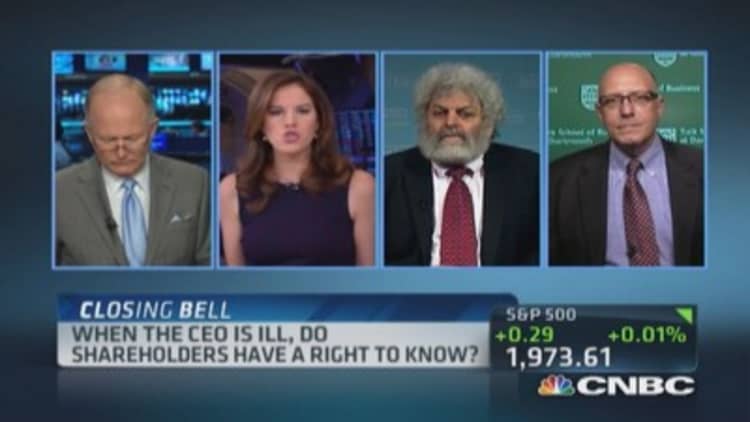University professors might be smart when talking about physics, Russian novelists and foreign affairs, but their bosses might need a remedial course in health-care costs.
Annual spending on health care among public sector and education industries—including colleges—has exploded in recent years, greatly outpacing the overall spending trend for all industries and any single one, according to data collected by Towers Watson.
Health costs in the public sector/education area jumped from $11,294 per employee in 2010, to $15,620 per worker in 2014—a 38 percent hike.
Read MoreObamacare's 95% solution: Automatic re-enrollment
During that same time—when overall health-care costs for all industries grew an average of 22 percent—the public sector/education category went from having the lowest costs per employee to the fourth-highest costs out of eight industry categories tracked by Towers Watson in its recent National Business Group on Health report.
The sharp change in that particular industry category highlights a potential need by employers in that particular sector to make changes in managing their health-care costs.
But the data also underscores the often big differences that exist among the eight industry categories in the total dollars spent on health-care costs—which comprises the employers' cost of insuring a worker, and what the employee pays in insurance premiums and out-of-pocket costs.
For example, energy and utility companies spend an average of $16,806 per worker. In contrast, wholesale and retail companies spend an average of $13,775 per worker—a gap of more than $3,000 per worker.
Read MoreObamacare autopilot: Making it easy could cost you
Two other sectors, IT/Telecom and health care, had health-care costs in excess of $16,000 per worker. Three other categories besides wholesale/retail had costs lower than $15,000 per worker.
Ron Fontanetta, a senior health-care consulting leader at Towers Watson, said that to manage their health costs effectively, companies need to pay attention to how they stand relative to their peers.

But in addition to keeping an eye on the costs typically paid within the industry, he said, companies also need to be aware of overall trends that could shed light on how their health spending can be adjusted.
"Companies should be benchmarking their costs . . . both within their sector and, importantly, across sectors," Fontanetta said. Then, he said, "companies should conduct an evaluation of the primary drivers of these costs, and develop strategies toward higher performance."
The energy/utilities sector, for example, is the leader in health costs because those companies' insurance plans tend to cover more of the costs of medical benefits than in other sectors.
Employees in that sector "will have lower employee cost-sharing when they use a plan," Fontanetta said. "They might have a $200 deductible," while a retail worker might have a $750 deductible, he said.
Read MoreHow does your state stack up with Obamacare?
Another difference between the biggest-spending sector and the lowest-spending sector is who is covered by their plans, Fontanetta said.
Retail companies tend to have a higher percentage of unmarried workers, meaning there are less dependents to be covered on a health plans than in the energy/utilities sectors, which had a higher percentage of married workers.
And retail companies, on average, required that workers foot a significantly higher percentage of the costs of insuring their dependents than do energy and utility, which are among the most generous in covering dependents' costs.
Lastly, the average age of energy/utility workers, Fontanetta said, is around 47 years old, compared with the average age in retail, which is around age 41.
"That six-year age difference doesn't sound like a lot, but it could account for 10 percent or more of the cost difference," Fontanetta said, noting that the older workers present more of an "illness burden."
"Richer plan designs, higher coverage of dependents, higher illness burdens, those are the primary reasons that you see a lot of the differences that you're seeing," he said.
Read MoreThe underworld of cheap drugs
Fontanetta also pointed out that "consumerism"—how people buy their medical services—can affect overall costs, and is an area that companies might want to look at to lower their health-care spending.
The pharmaceutical industry, which is part of the health-care sector, has some of the highest health-care spending costs in the nation, Fontanetta noted.
In addition to their rich plan design and high dependent-care costs, he said, "there's a bias for brand-name drugs" among their employees.
People who work at pharmaceutical companies are more apt, on average, to get a brand-name drug than a cheaper, generic version of the medication, he said.
Read MoreObamacare views will skew votes this fall
At companies that do have relatively high generic drug usage, he said, their overall "drug costs may be as much as 15 percent lower."
If companies identify such cost drivers, they can then look at making a change to bring their overall spending down, Fontanetta said.
"A lot of companies take a rigorous management approach . . . they take actions to mitigate those costs," he said.
Those actions can include changing health plans, changing pharmacy benefit managers, changing the amount that the company subsidizes employee and dependent care, and contracting with medical providers for certain procedures at a set rate.
Read MoreData flaws dog US health law sign-ups: Report
"Those companies that spend a lot more than average are not doing that effectively," he said.
—By CNBC's Dan Mangan


